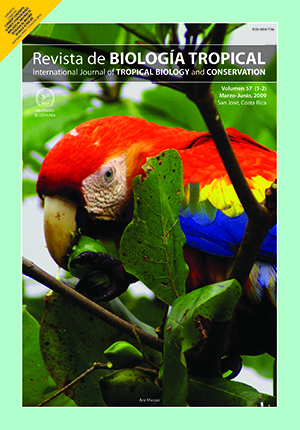Resumen
Las lianas son componentes importantes de los bosques tropicales y tienen importantes impactos en la diversidad, la estructura y la dinámica de los bosques tropicales. El presente estudio documenta la flora de lianas en una región tropical estacional china. La riqueza de especies, abundancia, clases de tamaño y patrones espaciales de distribución de las lianas fueron investigados en tres parcelas de una hectárea de bosque tropical estacional lluvioso, en Xishuangbanna, SW China. Todas las lianas con ≥ 2 cm de diámetro a la altura del pecho (DAP) fueron medidas, etiquetadas e identificadas. Un total de 458 tallos de lianas pertenecientes a 95 especies (que van de 38 a 50 especies/ha), 59 géneros y 32 familias se registraron en las tres parcelas. Las familias mejor representadas fueron Loganiaceae, Annonceae, Papilionaceae, Apocynaceae y Rhamnaceae. Papilionaceae (14 especies registradas) fue la de mayor importancia. La densidad de población, área basal y el índice de valor de importancia (IVI) varió mucho a través de las tres parcelas. Strychnos cathayensis, Byttneria grandifolia y Bousigonia mekongensis fueron las especies dominantes en términos de IVI en las tres parcelas. La media de la biomasa aérea de lianas (3 396 kg/ha) representó el 1.4% de la biomasa aérea total de la comunidad. La abundancia, biomasa y diversidad de lianas en bosques tropicales estacionales de Xishuangbanna son inferiores a los de zonas tropicales y bosques húmedos, pero superiores a los de los bosques tropicales secos. Este estudio proporciona nuevos datos sobre las lianas de una región geográfica que ha sido poco estudiada. Los resultados enfatizan que otros factores, además de la cantidad y la estacionalidad de la precipitación, deben ser considerados al examinar los patrones de la abundancia de lianas.##plugins.facebook.comentarios##

Esta obra está bajo una licencia internacional Creative Commons Atribución 4.0.
Derechos de autor 2009 Revista de Biología Tropical
Descargas
Los datos de descargas todavía no están disponibles.






